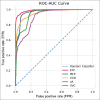Exploring the Potential of Machine Learning Algorithms to Improve Diffusion Nuclear Magnetic Resonance Imaging Models Analysis
- PMID: 39131437
- PMCID: PMC11309135
- DOI: 10.4103/jmp.jmp_10_24
Exploring the Potential of Machine Learning Algorithms to Improve Diffusion Nuclear Magnetic Resonance Imaging Models Analysis
Abstract
Purpose: This paper explores different machine learning (ML) algorithms for analyzing diffusion nuclear magnetic resonance imaging (dMRI) models when analytical fitting shows restrictions. It reviews various ML techniques for dMRI analysis and evaluates their performance on different b-values range datasets, comparing them with analytical methods.
Materials and methods: After standard fitting for reference, four sets of diffusion-weighted nuclear magnetic resonance images were used to train/test various ML algorithms for prediction of diffusion coefficient (D), pseudo-diffusion coefficient (D*), perfusion fraction (f), and kurtosis (K). ML classification algorithms, including extra-tree classifier (ETC), logistic regression, C-support vector, extra-gradient boost, and multilayer perceptron (MLP), were used to determine the existence of diffusion parameters (D, D*, f, and K) within single voxels. Regression algorithms, including linear regression, polynomial regression, ridge, lasso, random forest (RF), elastic-net, and support-vector machines, were used to estimate the value of the diffusion parameters. Performance was evaluated using accuracy (ACC), area under the curve (AUC) tests, and cross-validation root mean square error (RMSECV). Computational timing was also assessed.
Results: ETC and MLP were the best classifiers, with 94.1% and 91.7%, respectively, for the ACC test and 98.7% and 96.3% for the AUC test. For parameter estimation, RF algorithm yielded the most accurate results The RMSECV percentages were: 8.39% for D, 3.57% for D*, 4.52% for f, and 3.53% for K. After the training phase, the ML methods demonstrated a substantial decrease in computational time, being approximately 232 times faster than the conventional methods.
Conclusions: The findings suggest that ML algorithms can enhance the efficiency of dMRI model analysis and offer new perspectives on the microstructural and functional organization of biological tissues. This paper also discusses the limitations and future directions of ML-based dMRI analysis.
Keywords: Diffusion magnetic resonance imaging; intravoxel incoherent motion; kurtosis; machine learning.
Copyright: © 2024 Journal of Medical Physics.
Conflict of interest statement
There are no conflicts of interest.
Figures







Similar articles
-
Support vector machine for breast cancer classification using diffusion-weighted MRI histogram features: Preliminary study.J Magn Reson Imaging. 2018 May;47(5):1205-1216. doi: 10.1002/jmri.25873. Epub 2017 Oct 16. J Magn Reson Imaging. 2018. PMID: 29044896
-
Machine learning algorithms for outcome prediction in (chemo)radiotherapy: An empirical comparison of classifiers.Med Phys. 2018 Jul;45(7):3449-3459. doi: 10.1002/mp.12967. Epub 2018 Jun 13. Med Phys. 2018. PMID: 29763967 Free PMC article.
-
Comparison of methods for intravoxel incoherent motion parameter estimation in the brain from flow-compensated and non-flow-compensated diffusion-encoded data.Magn Reson Med. 2024 Jul;92(1):303-318. doi: 10.1002/mrm.30042. Epub 2024 Feb 6. Magn Reson Med. 2024. PMID: 38321596
-
The Roles of Diffusion Kurtosis Imaging and Intravoxel Incoherent Motion Diffusion-Weighted Imaging Parameters in Preoperative Evaluation of Pathological Grades and Microvascular Invasion in Hepatocellular Carcinoma.Front Oncol. 2022 May 11;12:884854. doi: 10.3389/fonc.2022.884854. eCollection 2022. Front Oncol. 2022. PMID: 35646649 Free PMC article.
-
Artificial intelligence in clinical care amidst COVID-19 pandemic: A systematic review.Comput Struct Biotechnol J. 2021;19:2833-2850. doi: 10.1016/j.csbj.2021.05.010. Epub 2021 May 7. Comput Struct Biotechnol J. 2021. PMID: 34025952 Free PMC article. Review.
References
-
- Le Bihan D. What can we see with IVIM MRI? Neuroimage. 2019;187:56–67. - PubMed
-
- Le Bihan D, Breton E, Lallemand D, Grenier P, Cabanis E, Laval Jeantet M. MR imaging of intravoxel incoherent motions: Application to diffusion and perfusion in neurologic disorders. Radiology. 1986;161:401–7. - PubMed
-
- Rosenkrantz AB, Padhani AR, Chenevert TL, Koh DM, De Keyzer F, Taouli B, et al. Body diffusion kurtosis imaging: Basic principles, applications, and considerations for clinical practice. J Magn Reson Imaging. 2015;42:1190–202. - PubMed
-
- Jensen JH, Helpern JA, Ramani A, Lu H, Kaczynski K. Diffusional kurtosis imaging: The quantification of non-Gaussian water diffusion by means of magnetic resonance imaging. Magn Reson Med. 2005;53:1432–40. - PubMed
LinkOut - more resources
Full Text Sources
